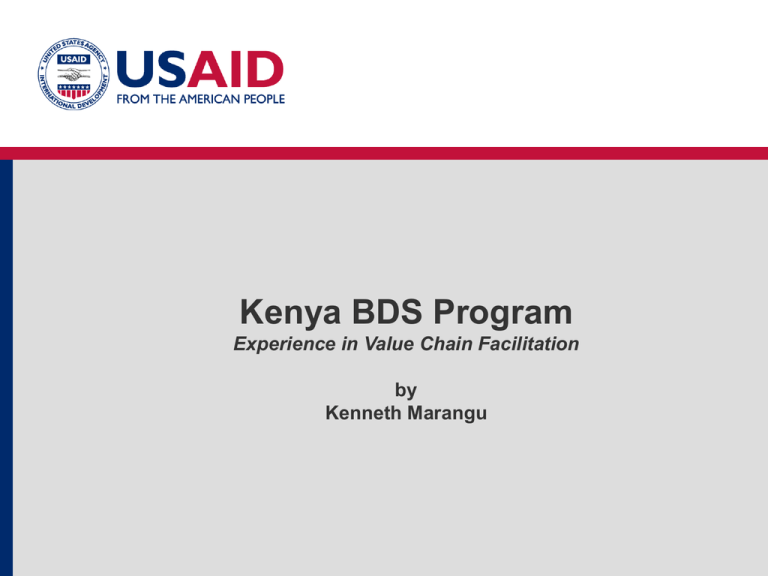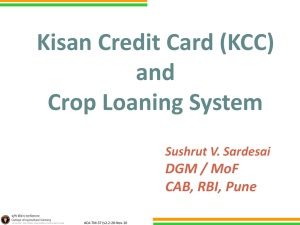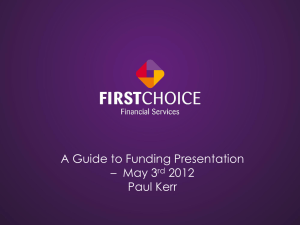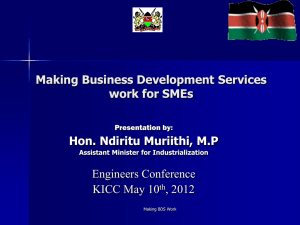The Value Chain Framework and Rural Finance
advertisement

Kenya BDS Program Experience in Value Chain Facilitation by Kenneth Marangu Presentation Agenda I. Background on Kenya BDS and the Approach to Value Chain Facilitation II. Example of Specific Value Chain Financing Intervention – Agrochemical Loan Product III. Key Messages Kenya BDS Program Overview 1. The Kenya BDS Program is a 6-year USAID funded activity implemented by the Emerging Markets Group (EMG) 2. The objective is to increase growth and incomes among rural micro- and small-enterprises through increased access to business services 3. The main areas of focus are: – Tree-fruits (passion, mango, avocado) – Lake Victoria Fish (Nile Perch, Tilapia, Omena) Kenya BDS – Facilitation Steps 1. Select Target Industry 2. Conduct Value Chain Analysis 3. Identify and Prioritize Constraints 4. Design Interventions 5. Tender Among Local Facilitators 6. Award, Support, and Monitor Tree-Fruits Value Chain – Constraints & Services Targeted Value Chain Retailing Constraint Poor Image of Kenyan Fruit Intervention / Service Required Conversion to High Value Varieties, Branding, Fair Trade Certification Exporting Wholesaling Processing Assembly Under-Developed Local Processing Industry High Cost of Product Assembly Horizontal Linkages Between Lead Firms, Processing Technologies Producer Group Formation, Clustering, Business Linkages Grading Production Input Supply Lack of Market Information Daily market price points, commodityspecific quantity and quality requirements High Cost and Lack of Access to Inputs Financial Services.to overcome high cost and low availability of inputs Extension R&D Low Knowledge and Skills in Crop Husbandry Quality control such as extension, certification, grades and standards From Analysis to Intervention – Example of a Targeted VC Financing Intervention Input Supply High Cost and Lack of Access to Inputs Agrochemical Loan Product Why Product is Needed • The combination of proper crop husbandry and spray services can increase grade 1 yields. • Farmers cannot gain access to or afford high cost (upfront) of agrochemicals, spray equipment, and labor. • Increasingly rigid production standards in Europe (EurepGap) require appropriate use of specified pesticides. • Loan program is a joint venture between Equity bank, KBDs -Market linkage/ group management companies and export market. Approach to Development of an Agrochemical Loan Product • Identify and develop independent agrochemical spray service providers. • Sensitize farmers educated on need for IPM and agrochemical spray services. • Approach financier to extend credit facility to farmer groups for agrochemical spray services, backed by strength of supply contract with exporter. • Establish check off system where the exporter pays farmers through the bank, who deducts scheduled loan payment before releasing net proceeds to the farmer group. • Agrochemical spray service providers consolidate service receipts on a monthly basis for payment from bank. Loan Process Mapping 1. Supply contract in place between farmers and exporter 2. Group farmers complete loan application form and chattel agreement for Equity (for overall season) 3. Application forms consolidated at group level and submitted to bank 4. Bank approves loan for season – Assumption that spray season is July - February – Assumption that repayment period is March June Loan Process Mapping (cont’d) 5. Farmer loan is activated on first day of spraying. 6. Group officials issue an in-house check to service provider. 7. Farmers sell fruits to exporter. 8. Exporter remits sales proceeds to Bank (with detail breaking down payment by group). 9. Bank pays farmer groups, less 20% deduction for loan repayment until cleared (must be cleared by June). Successes and Challenges • 3 Equity Branches approved loans for 130 groups, reaching 3,055 farmers and 23,916 trees on full commercial terms. • 40 commercial sprayers developed applying exporter (and EU)-approved pesticide regimes. • Program is fully commercial and backed upon the strength of smallholder supply contracts. Over 90% repayment during first pilot year of product. • Complications at branch level in managing new product. Complications at group level in reconciling both financial as well as spray records. • Poor harvesting season due to record floods lowers margins for farmers. • Side selling Key Messages 1. Value Chains are dynamic and complex. A facilitator must carefully prioritize interventions at key leverage points throughout the chain. 2. Facilitators must stay out of the supply chain and avoid direct provision of financial services or subsidizing the cost of business. Such actions distort commercial signals. 3. Marketing Marketing Marketing. 4. Identify the link of Financial intervention need in the context of the whole value chain. AHSANTENI QUESTIONS ?










